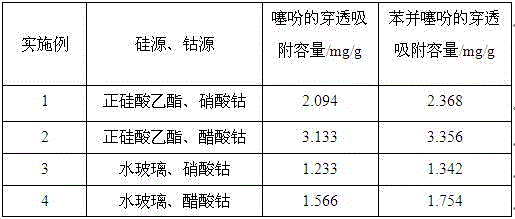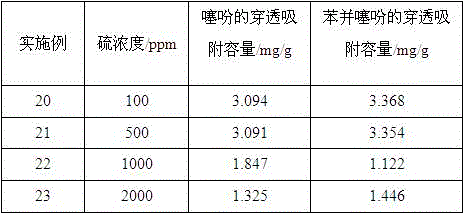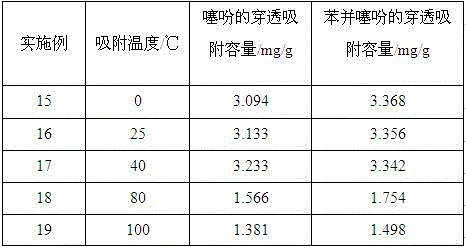Method using SiO2-CoO composite aerogel as absorbent to remove thiophene sulfur in gasoline
A composite airgel and adsorbent technology, applied in chemical instruments and methods, processing hydrocarbon oil, refining hydrocarbon oil, etc., to achieve good adsorption performance, low requirements, and convenient operation
- Summary
- Abstract
- Description
- Claims
- Application Information
AI Technical Summary
Problems solved by technology
Method used
Image
Examples
Embodiment 1-4
[0025] Examples 1-4: SiO with different silicon sources and cobalt sources 2 Effect of -CoO Composite Airgel on Adsorption of Thiophene Sulfides in Simulated Gasoline
[0026] SiO prepared by sol-gel method 2 In the -CoO composite airgel, the silicon sources used include tetraethyl orthosilicate and water glass, and the cobalt sources include cobalt nitrate and cobalt acetate. The prepared SiO 2 -CoO composite airgel was used for penetration adsorption desulfurization experiment, the specific operation is as follows: In the fixed bed reactor, the bottom layer is filled with an appropriate amount of absorbent cotton, and then filled with 1g of SiO2-CoO composite airgel and an appropriate amount of quartz sand. Before the adsorption experiment started, the packed adsorbent was fully wetted with n-heptane. Feed simulated gasoline, and collect the adsorbed simulated gasoline at the outlet of the lower end of the reactor for gas chromatographic analysis. The obtained breakthrou...
Embodiment 5-9
[0030] Examples 5-9: SiO with different silicon-cobalt molar ratios 2 Effect of -CoO Composite Airgel on Adsorption of Thiophene Sulfides in Simulated Gasoline
[0031] The SiO2-CoO composite aerogels with silicon-cobalt molar ratios of 5, 10, 50, 100, and 200 were selected to conduct penetration adsorption experiments on thiophene sulfides in simulated gasoline. The operation of the breakthrough adsorption experiment is the same as in Examples 1-4, and the adsorption results are shown in Table 2.
[0032] Table 2 Effects of different silicon-cobalt molar ratios on the adsorption of thiophene sulfides in simulated gasoline
[0033]
[0034] It can be seen from Table 2 that the penetration adsorption capacity of SiO2-CoO composite aerogels for thiophene and benzothiophene increases with the decrease of silicon-cobalt molar ratio, that is, the increase of cobalt content. When the silicon-cobalt molar ratio is less than 50, the breakthrough adsorption capacity of thiophene a...
Embodiment example 10~14
[0035] Implementation Cases 10~14: Effects of different space velocities on SiO 2 -CoO Composite Airgel Adsorption Simulated Effect of Thiophene Sulfides in Gasoline
[0036] Choose SiO with a molar ratio of silicon to cobalt of 50 2 -CoO composite airgel. at an airspeed of 1h -1 、3h -1 、5h -1 、8h -1 、10h -1 Next, the breakthrough adsorption experiment was carried out on thiophene sulfides in simulated gasoline. The operation of the breakthrough adsorption experiment is the same as in Examples 1-4, and the adsorption results are shown in Table 3.
[0037] Table 3 Effects of different space velocities on adsorption of thiophene sulfides in simulated gasoline
[0038]
[0039] It can be seen from Table 3 that the breakthrough adsorption capacity of thiophene and benzothiophene will gradually increase with the decrease of space velocity. When the space velocity decreases to 5h -1 After that, the breakthrough adsorption capacity for thiophene sulfides does not change m...
PUM
 Login to View More
Login to View More Abstract
Description
Claims
Application Information
 Login to View More
Login to View More - R&D
- Intellectual Property
- Life Sciences
- Materials
- Tech Scout
- Unparalleled Data Quality
- Higher Quality Content
- 60% Fewer Hallucinations
Browse by: Latest US Patents, China's latest patents, Technical Efficacy Thesaurus, Application Domain, Technology Topic, Popular Technical Reports.
© 2025 PatSnap. All rights reserved.Legal|Privacy policy|Modern Slavery Act Transparency Statement|Sitemap|About US| Contact US: help@patsnap.com



